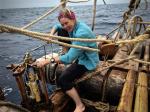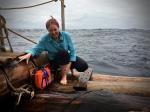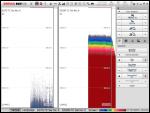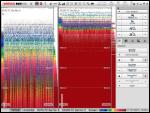(2015-12-07) Now that we have managed to make a deep-water cast, thanks to the hard, dedicated work by the crew on Tupac, it is time to reflect a bit on the importance of such deep-water measurements. There are many ways to make measurements at the sea surface: you can place sensors on satellites and they can measure anything from sea surface height to chlorophyll and salinity. You can put sensors on instruments you bring out to sea, and you simply tie the instrument to the side of the ship. We have many such sensors tied to our raft. And you can analyze the water directly, using a variety of chemicals, alternatively bring the samples back to shore for further analysis as we will do.
But below the sea surface electromagnetic waves won't travel, so to measure conditions over long distances you need to use sound-waves. We have two devices using sound-waves on board: the current meter, which measures the ocean current in the upper 20 meters under the raft. And the echo sounder, which measures animal life down to 1000 meters. What you actually measure depends a lot on the choice of frequencies and power.
But sometimes you want to know precisely the value at given places in the water column, and in that case you are best off sending the instrument to that place. Which is what Tupac did yesterday :). Measurements of temperature, salinity, chlorophyll and oxygen every few centimeters down to 1000 meters depth. They measured the top layer, very well mixed by the winds, full of oxygen and with a lovely swimming temperature of 22 degrees Celsius. Beneath this the crossed the first oxygen minimum zone, between 100 and 200 meters. Then, continuing downwards, the temperature and salinity would have stayed relatively homogeneous for a while (warm and salty), until the next oxygen minimum is reached at about 1000 meters. Beneath this, around 2000 meters the waters start getting very cold, and by the time you are below 3000 meters you're down to two or three degrees. But even these cold water-masses have experienced warming due to climate change! It is very hard to make such deep water measurements from a balsa raft.Just the rope needed to get down to the bottom takes lots of space. And the power needed to bring the instrument up is enormous. So I'm very proud of the Tupac crew who made a successful attempt and got to 1000 meters. And I'm cheering them on to make a new try, for two thousand meters. In that case we will establish the oxygen content and extent of BOTH oxygen minimum zones out in the middle of the southeast Pacific in this hefty El Nino year 2015 :)
What the Ocean would have said.
On oxygen @ cop21
Dear delegates, dignitaries, ladies and gentlemen,
It is a great honor to be given the floor at the 21st Conference of the Parties here in Paris – a meeting of enormous consequences for Earth, its elements, and all its creatures, great and small. The agreements that are reached at the 2015 climate summit will have consequences for times so far into the future that only the ocean and the mountains will remember.
Today I wish to turn your attention to an aspect of climate change that you have quite possibly never considered. It is an issue of great importance and grave consequences for the ocean, namely that of oxygen depletion. You may not know this, but the animals in the ocean need oxygen to live, just like the animals at land. And, as on land, it is the plants that produce the oxygen. In fact, the ocean normally produces much more oxygen than it needs, and therefore shares its oxygen with the animals in land, including you humans. Nearly half the oxygen you use originates in the ocean. So you see, we, the Ocean, provide a great service as oxygen producer to all Earth's creatures, wherever they live.
And I tell you about this because I fear that we, the Ocean, cannot continue to provide this service at the same high standard much longer. We cannot even supply enough oxygen for our own creatures anymore. "Why?" you may ask. Well, the ultimate reason is the emission of carbon dioxide associated with combustion of fossil fuels. This emission creates temperature increases in the ocean, just like on land. And when the surface ocean gets warmer it gets more buoyant, making it difficult to mix the surface waters with the deep water. Here it gets a little complicated, but no less important: the ocean plants that produce the oxygen live in the surface waters. Less mixing by the winds means less oxygen transported downwards, to where the ocean animals need it. And less mixing means fewer nutrients coming up from the deep ocean to provide food for the ocean plants. Less food means fewer plants and thereby even less oxygen production. This is a worrysome trend that we, the Ocean, worry deeply about, not just because it affects our own creatures, but because it affects all Earth's creatures, great and small, rich and poor, women and man, child and old.
There is only one way to stop this worrysome trend, namely to curb the emissions of carbon dioxide. Every day and every year that you postpone this decision, we, the Ocean, weakens and our services – which you all depend upon – deteriorate. We beg of you: if not for us, then your you, make a decision. Produce an agreement at this summit that will put us, the Ocean, back on the path towards health, so that we can, once again, be the top quality oxygen producer that all Earth's creatures, great and small, depend upon.
Thank you kindly for listening.
Most humbly,
We, the Ocean.
What would the Ocean have Said?
Thoughts at the dawn of the 2015 Climate Summit in Paris
What is it about nature? Why is it so beautiful? Why is it ALWAYS so beautiful? Why does it hide so well all its scars and bruises? Why does it let us get away with it all?
I sit on a balsa raft in the Pacific Ocean, leisurely sailing from Peru to Easter Island. I watch the swells go by, the sun come and go, the small squalls pass by, the winds steadily blowing out of the southeast, allowing us, just barely, to steer so far upwind that we have a justified hope of reaching Easter Island before Christmas. In fact, we are two rafts, and both are packed to capacity with research equipment to document the state of the southeast Pacific during this (southern hemisphere) spring, which happens to be in a gigantic El Nino year.
One of the rafts, the Tupac Yupanqui, is dedicated to monitoring plastic pollution. We are crossing one of the five major plastic accumulation regions ("gyres") of the World Oceans, and we have brought many different instruments to acquire a solid data base on this year's gyre. But what do we see? Nothing. Nada. Okey, a coke bottle twice so far, but otherwise: not one thing. The steady, intense winds have efficiently mixed down the plastic so that it looks just as gorgeous as it did 70 years ago when Thor Heyerdahl crossed these seas with the Kon Tiki. "Our" Pacific is probably a bit greyer than the blue colors his crew so eloquently described, but that's because of the weather, not because of some color contamination.
Our instruments will be able to detect particles smaller than the human eye can see, and will be able to record with high precision what the broken-down plastic - the microplastic - consists of and where it most likely came from. Our research therefore adds to the never-ending, painstaking collecting of data that has been the task of the scientist since times immemorial. And microplastic is one of those particularly insidious pollutants; it attracts toxins and it folows the food web of the marine ecosystem, thus slowly poisoning the entire chain. But it doesn't really matter what the scientist collects, does it? Because no one can see it. Can't see the plastic in the oceans nor the poison in the animals. The ocean is gorgeous. And the animal life is up to par. I see dolphins, dorados, whales, flying fish and a multitude of birds. In fact, our raft has turned into its own little ecosystem which we monitor with cameras every day. To us, the marine life looks nothing but happy.
My raft, the Rahiti Tane, is packed with equipment to monitor climate change. We measure ocean temperature, ocean CO2-content, ocean oxygen content, ocean acidity. We know the oceans are behaving like a huge buffer in Earth's big effort to mitigate climate change: the oceans take up a third of all the CO2 that mankind emits every year. And it takes up almost all the heat created by climate change. Almost all! Sure, the global atmospheric temperature is rising, decade by decade, with all its consequences in terms of heat waves, extrem weather, floods and droughts. But that's only a few percent of the heat accumulated on Earth. More than 90 % of that heat is stored, each year, in the oceans. How is that for an efficient buffer? Without the oceans we would already be facing much harsher changes due to climate change. The oceans spare us from facing reality. Damned nature.
Meanwhile I rock gently back and forth on my raft – the Rahiti Tane, so full of personality and crewed with such a lovely croup of people – genuinely proud to be running a full-scale research program purely on solar power. I think of all the interesting research questions I get to address. My only concern is that we are running out of fuses. (Well, and that we are almost out of chocolate...). And then the thought strikes me: this is all in vain. Nobody will care. There cannot possibly be anything wrong with something so beautiful. Damned nature.
Could the ocean, even if it were sitting at the negotiating table at the climate summit in Paris, arguing for the strong climate agreement it really needs, convince anybody to sign anything? I do not know. Because the ocean is SO beautiful. But what would it have said? Now, THAT is an interesting question.
Sunshine!
(2015-11-24) It is Tuesday November 24, we are west of 90 W, and we have entered a new type of weather, after being pounded with strong southeasterlies, huge swells, and cloudy, humid conditions for more than two weeks. Today was sunny, calm and wonderful. So sunny in fact, that we pulled out yet another instrument from the Rahiti Tane toybox. In this case a "Microtop" to measure aerosol optical depth of the atmosphere over oceans. These instruments require a clear view of the sun, so ours had so far been collecting dust.
With the Microtop measurements we participate in a global network of 500 voluntary ships who contribute to monitor how the aerosol content of the atmosphere changes with space and time. The program is coordinated by NASA. Remember, these particles have an overall cooling effect on the atmosphere, but regionally they can have a huge impact on how temperature and even precipitation varies from place to place. So that's why it is so important that the voluntary ships keep collecting their data, year in and year out. And today, we did our little part :)














